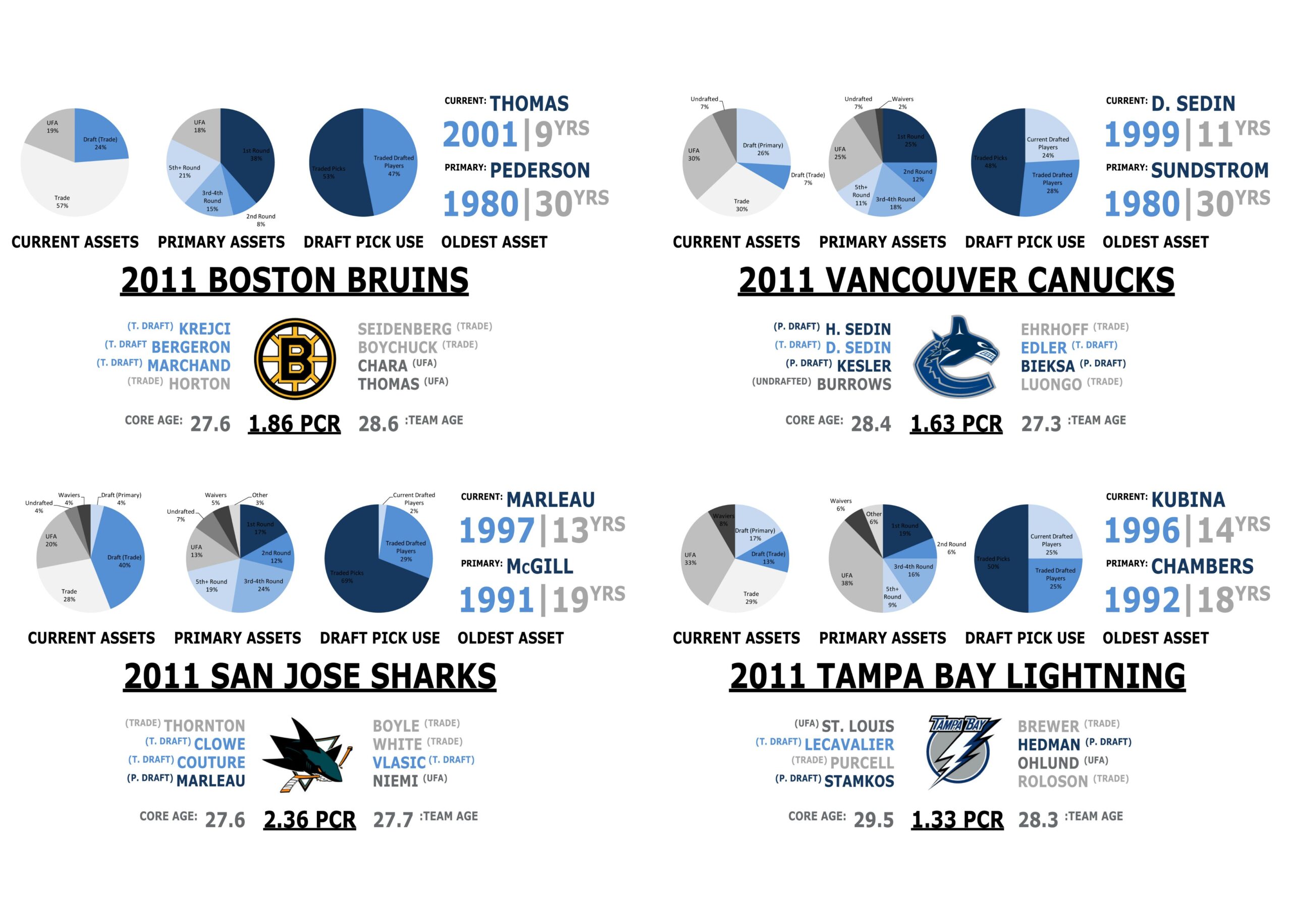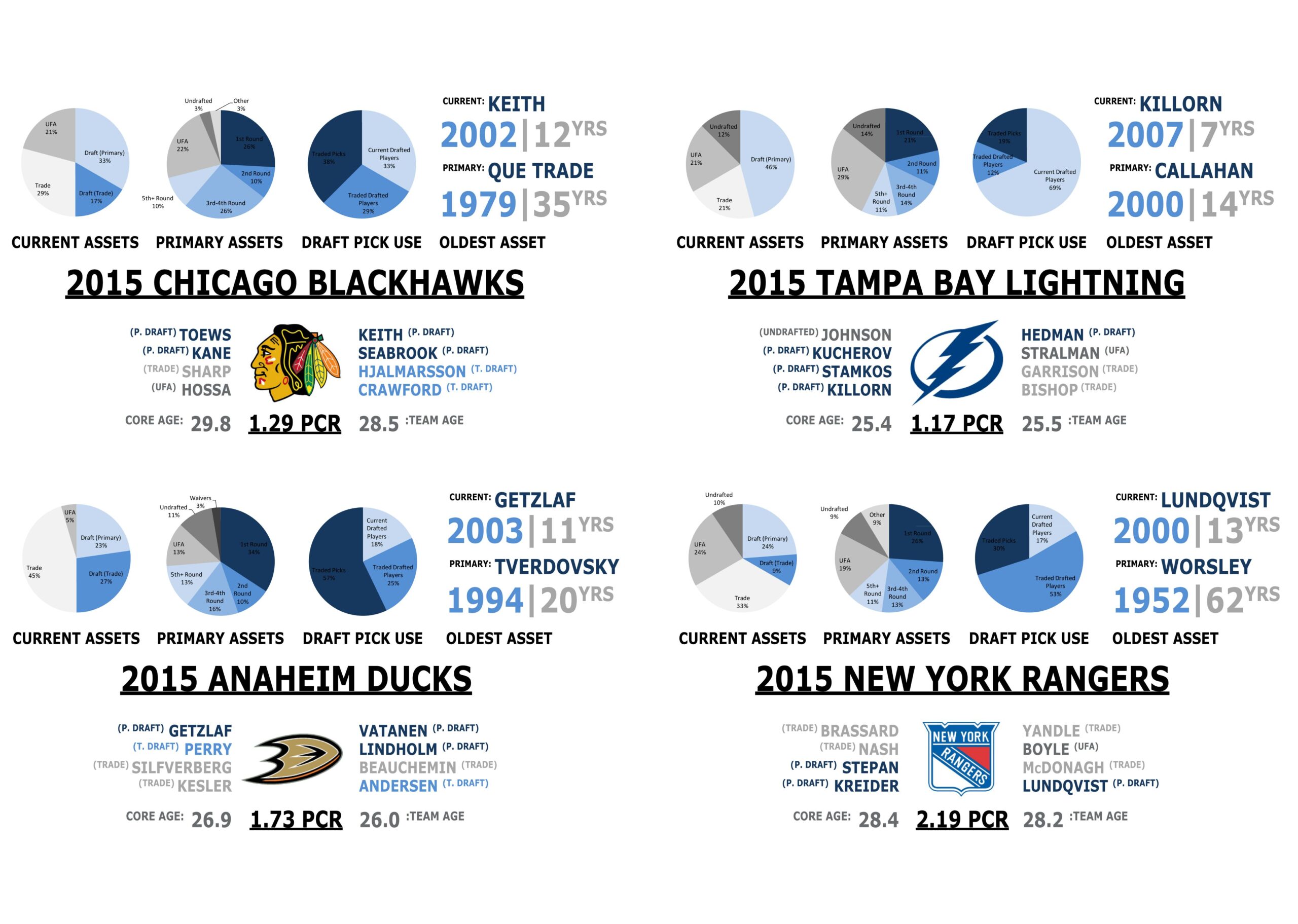© 2025 ALLCITY Network Inc.
All rights reserved.

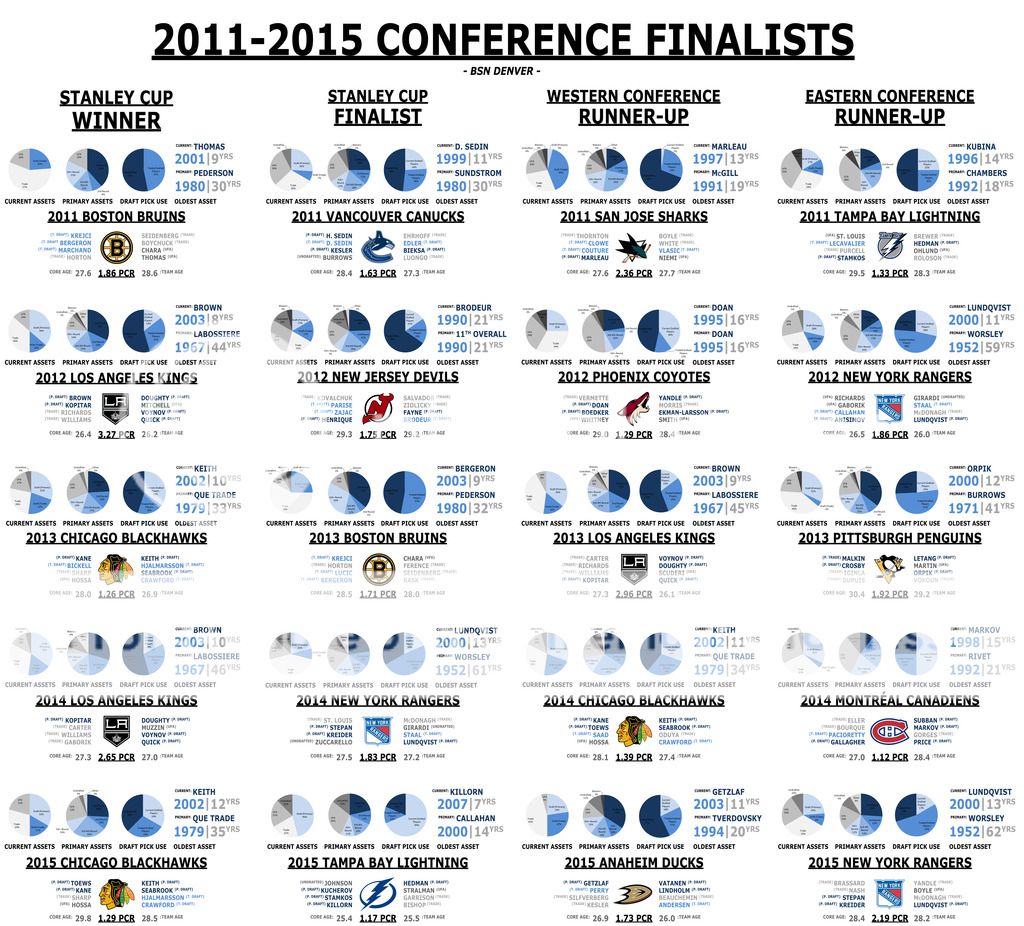
(Click Here for Full Size Image)
As teams settled into the salary cap era, the league slowly transitioned into what it is today. Gone are the times where a single strategy would almost guarantee a win. Yes, drafting is still very important (not to mention the basis for all of the Chicago and LA Cup wins), but trade or trade/UFA teams have done quite well for themselves in this landscape too. It seems diversity in acquisition has become best way to stay competitive in the modern NHL.
Even so, there are certain trends that have been coming to light over these past few years. Could they be the key to the next era of team building?
2011 Boston Bruins Data Sheet
2011 Vancouver Canucks Data Sheet
2011 San Jose Sharks Data Sheet
2011 Tampa Bay Lightning Data Sheet
The 2011 conference finals is unique among post-lockout seasons. It carries the unusual distinction of being the only time since the institution of the salary cap where all teams had fewer than 50 percent drafted players. San Jose came close to the mark with 44 percent drafted, but 52 percent still belonged to the realm of trades and free agents.
Boston, the eventual Cup winners, took this idea to the extreme. While three of their core players were drafted by the club, none of the players on that roster were original draft picks. This meant that everyone but the handful of UFAs were products of trades, which is probably why their rebuild went so quickly. They also weren’t shy about trading away draft picks, including multiple first rounders. Building the team took both luck and skill, but the Bruins of 2011 are the textbook example of how to construct a trade-based winner in a capped age.
San Jose was right with them, as Marleau was the only primary pick on their roster. Unfortunately, they fell short of their goal of winning the franchise’s first Stanley Cup, and the number of draft picks they traded away seem to be making their current to rebuild or not to rebuild predicament a bit more complicated. The same can be said for Vancouver, who came within one game of a Cup and hasn’t been back since.
The transition of Tampa Bay will be discussed in greater detail in tomorrow’s post, but the 2011 iteration marks an interesting midpoint between their 2004 Cup team and their competitive 2015 version. Despite years of high picks on either side of this campaign, they still made it to the third round in 2011. Was it a fluke? Probably, but it’s still an interesting phenomenon worth discussion. As mentioned, stop back tomorrow.
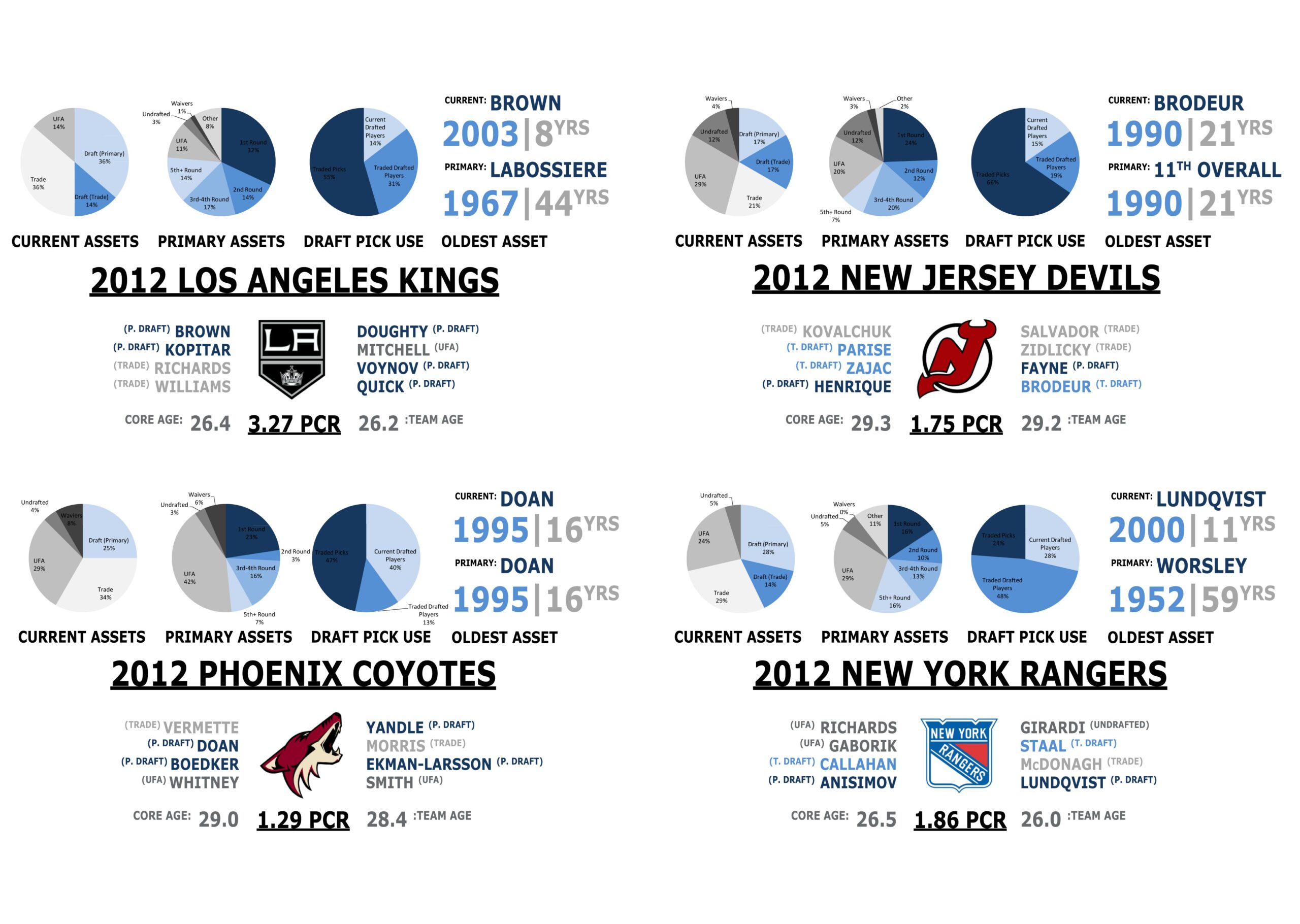
2012 LA Kings Data Sheet
2012 New Jersey Devils Data Sheet
2012 Phoenix Coyotes Data Sheet
2012 New York Rangers
Los Angeles brought a return of draft-based mentality to the Stanley Cup with their win in 2012. Much like Chicago’s early wins, the club was built on a combination of primary draft and trades. They were far more willing to trade picks than their midwestern rival, but both clubs relied heavily on the first round, drafted well late, snagged a core player in the third round (Keith for Chicago, Quick for LA), and had a few unusually productive drafts in a row.
Even though the two teams play very different styles on the ice, they’re constructed in very similar ways off it. As they’ve traded off destroying the league for the past four years, it’s safe to say it’s a recipe worth emulating.
2012 also marked the return of the Devils to the Stanley Cup Finals. Although they dominated the pre-lockout league with a draft/trade strategy ahead of its time, the 2012 version was very UFA heavy and relied on more traded draft picks than it had before. It also was the last year of Zach Parise in New Jersey, and the second to final season of Kovalchuk on this side of the Pacific. Like Tampa Bay a year earlier, the roster was in transition between two cores, and there was a large amount of luck involved in making the playoffs as an 8th seed, let alone reaching the Finals. It was an impressive run that deserves praise, but it certainly didn’t result in much sustained success.
The same can be said for Phoenix. Although they had made the playoffs for the past two seasons, they were knocked out in the first round both times. 2012 marked their first deep run since the club moved to Arizona, but it also stands as their last post-season bid to date.
The Rangers are a slightly different story, as they’ll appear in this article twice more. Over the years, they’ve actually become less draft based, relying more and more on undrafted players and trades to fill out their roster. There’s something to be said for their sustained success without the reliance on Top 5 draft picks. Without a doubt, the Rangers are a team to keep in mind as the next phase of this series begins.
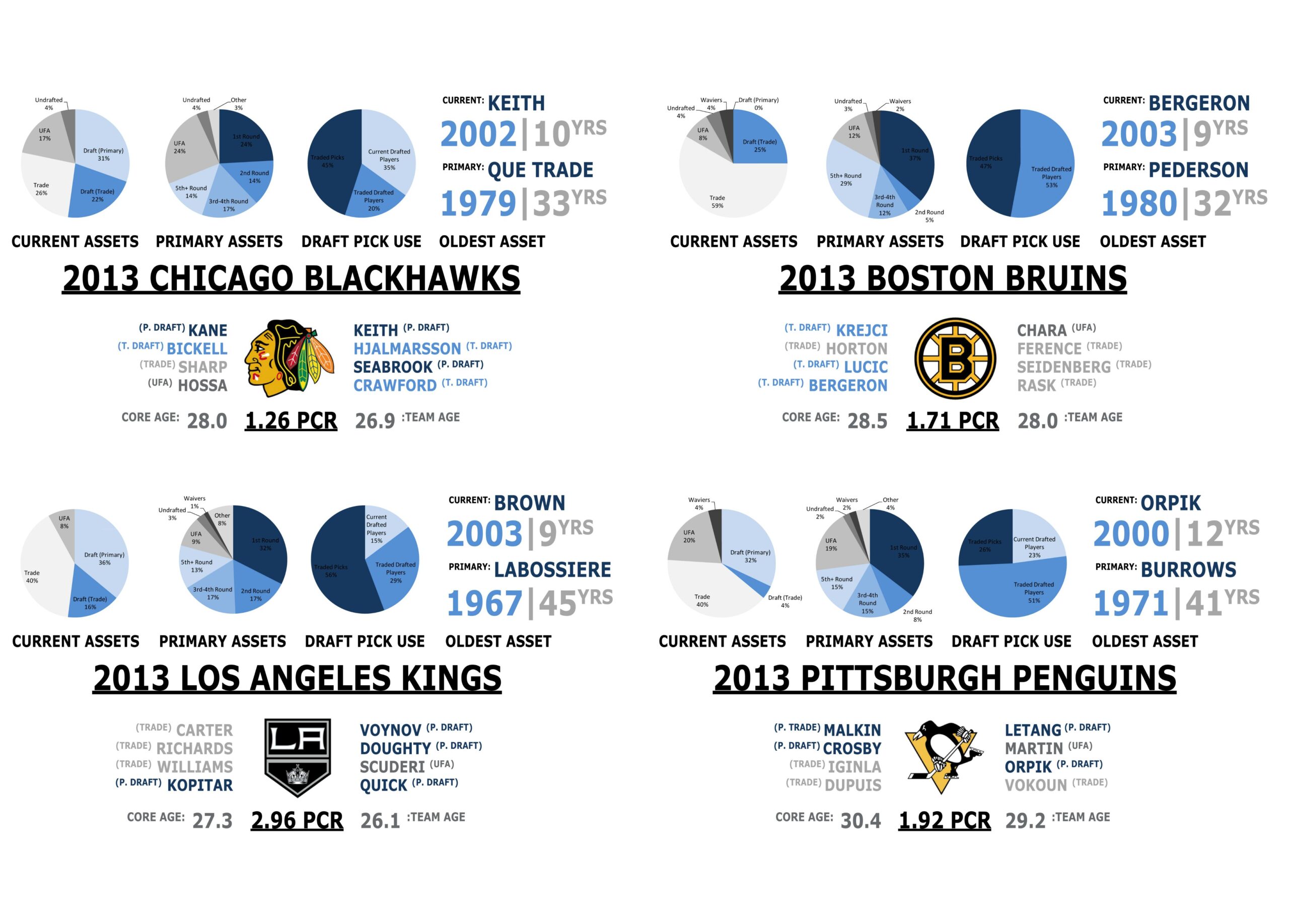
2013 Chicago Blackhawks Data Sheet
2013 Boston Bruins Data Sheet
2013 LA Kings Data Sheet
2013 Pittsburgh Penguins Data Sheet
If anyone believed that a lockout shortened season would help more underdogs make it deep into the playoffs, they were sadly mistaken. The four conference finalists also happened to be the past four Stanley Cup winners. It seems the extra rest did them well.
2009’s Champion, the Pittsburgh Penguins, had become slightly more trade based in the subsequent four seasons. Their core had turned over somewhat, but in doing so, it still had aged three years and was now above the 30 mark. Interestingly, Vokoun, not Fluery, lead the team in playoff GP that year, probably due to Fleury’s .883 Sv%. They were swept by the Bruins after scoring only two goals in that series.
Meanwhile, 2010’s Champion managed to score another Stanley Cup in 2013. The Hawks’ core was four years older and more experienced this time around, and the roster made less use of UFAs and trades than their earlier counterpart. The cap crunch after their first win proved to barely be a bump in the road as draft picks filled in behind the departed players.
2011’s Champion still had no primary assets to speak of, but a few undrafted and waiver pickups had sneaked onto the Bruins’ roster. Somehow, the team had become even more trade based, crawling up from 57 to 59 percent. Boston was also holding onto their draft picks a bit more, opting to trade established players and prospects instead.
Finally, last year’s winner, the Kings decided on the if it ain’t broke don’t fix it approach. Primary draft picks and trades still served as the heart of their approach, and it continued to work.

2014 LA Kings Data Sheet
2014 New York Rangers Data Sheet
2014 Chicago Blackhawks Data Sheet
2014 Montreal Canadiens Data Sheet
The Kings won. The Hawks almost won. The Rangers showed up again. There’s really not much more to say on those fronts, so, let’s talk about the Canadiens.
Unlike the dynasty days in the late 1970s, the 2014 version of the club relied very little on the hallmark draft picks via trades approach. A recent rebuild had killed the trees dating back to that era, even though quite a few players on the modern roster were the result of a swap. Numerous UFAs populated the team, which is probably why the Habs were the oldest of the four Conference Finalists this year. They fell to the Eastern Conference Champion in six.
Their predicament in 2010 was much the same. The roster at that time was even more heavily UFA-based, and they had traded an even higher percentage of their draft picks away. However, they still came in second in the East. Unfortunately, the last time the club won the East and made it to the Stanley Cup Finals was 1993, which is now before some of their players were born. It will be interesting to see if the club climbs back to the top of the NHL within the next few years or is destined to be a second round exit type team for the lifespan of the current core.
2015 Chicago Blackhawks Data Sheet
2015 Tampa Bay Lightning Data Sheet
2015 Anaheim Ducks Data Sheet
2015 New York Rangers Data Sheet
Finally, we find ourselves back at the present. Like most of the teams of this era, the competitive organizations from earlier this summer feature draft picks in core roles, trades and UFAs accounting for around half the roster, and first round picks cementing their roles as critical assets.
However, two of the clubs featured undrafted players, particularly Tampa Bay. If there’s anything the past 39 years of hockey history has taught, it’s that the trailblazers in roster construction are usually the teams that do very well. Could the rise of undrafted players be the next untapped frontier? Only time will tell.
Comments
Share your thoughts
Join the conversation



